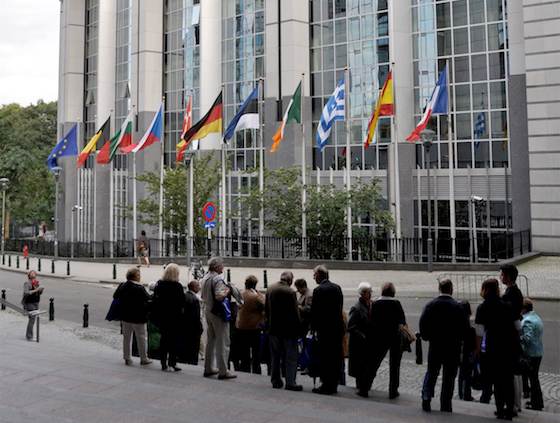- MENU
- HOME
- SEARCH
- WORLD
- MAIN
- AFRICA
- ASIA
- BALKANS
- EUROPE
- LATIN AMERICA
- MIDDLE EAST
- United Kingdom
- United States
- Argentina
- Australia
- Austria
- Benelux
- Brazil
- Canada
- China
- France
- Germany
- Greece
- Hungary
- India
- Indonesia
- Ireland
- Israel
- Italy
- Japan
- Korea
- Mexico
- New Zealand
- Pakistan
- Philippines
- Poland
- Russia
- South Africa
- Spain
- Taiwan
- Turkey
- USA
- BUSINESS
- WEALTH
- STOCKS
- TECH
- HEALTH
- LIFESTYLE
- ENTERTAINMENT
- SPORTS
- RSS
- iHaveNet.com: Vacation Travel
by Rick Steves

Visiting Brussels
Just as the European Union has transformed Europe, it has also transformed Belgium's capital -- Brussels. Once a minor trading hub, Brussels today is multicultural, hosting politicians and businesspeople (and immigrants) from around the globe -- and featuring a world of ethnic restaurants. The city hosts 400 embassies (the USA has three here, one each for the EU,
The EU is literally changing the demographic makeup of the city. As the EU tries to accommodate its 23 official languages (and it does, in some ways), the practical language of governance has become English. The EU has had such an impact on Brussels that some say in a generation, English will become the city's first language.
Despite these changes, Brussels remains a rich, chocolaty mix of food and culture. Tourists usually make a beeline to Brussels' Grand Place -- my favorite town square in Northern Europe -- blitz the city's art museums, and then get their pictures taken in front of the famous Manneken-Pis peeing-boy statue.
But visitors should consider Brussels' EU sights as well. A short bus or Metro ride from Grand Place is the European Parliament, a sprawling complex of glass skyscrapers with a cacophony of black-suited politicians speaking all the different Euro-languages. It's exciting just to be here -- a fly on the wall of a place that aspires to chart the future of Europe. The 785 parliament members (who also meet in Strasbourg, France) represent 27 countries and shape Europe with a $168 billion budget.
To welcome visitors, the EU recently spent about $30 million on a high-tech center -- the Parlamentarium. You'll see a short film projected on a 360-degree screen about the workings of the parliament, go on a virtual tour through all 27 member countries, and even walk across a huge map of Europe with more than 90 interactive points.
The only way to get inside the European Parliament itself is to join a free, 45-minute audioguide tour. The slow-paced audioguide -- with helpful video illustrations -- dryly takes you through the history of the EU, as well as its current structure and procedures. You'll learn how early visionary utopians (like Winston Churchill, who in 1946 called for a "United States of Europe") led the way as Europe gradually evolved into the
From the balcony overlooking the building's lobby, you'll see the giant Confluence sculpture with moving metal-wire pieces -- representing people coming together for a common purpose. The audioguide tells you all about the building itself: In line with EU idealism, it's functional, transparent, and very "green."
The grand finale is the vast "hemicycle," where the members of the European Parliament sit. Parliamentarians representing 160 different national political parties, organized into seven different voting blocs based on political ideals (rather than nationality), hash out pan-European issues in this hall. It's one of the largest multilingual operations on the planet.
As you tour the headquarters, consider this: Europe has had its economic woes the last few years. (Who hasn't?) But a bold and ambitious experiment like the
Naysayers continue to predict the imminent collapse of Europe. But what these people don't understand is that European unity is not just a convenient political talking point that's easily abandoned in tough times. It's a way of life that most Europeans deeply believe in. A visit to Brussels and the EU headquarters proves this point: Ultimately Europeans believe as fiercely in unity, cooperation, and celebrating diversity as Americans believe in life, liberty, and the pursuit of happiness.
Where to Stay in Brussels:
Hotel Welcome offers 16 outrageously creative rooms, exuberantly decorated with artifacts from around the world (splurge, www.hotelwelcome.com). Hotel Ibis Centre Ste. Catherine is a big, impersonal, perfectly comfortable business hotel in a great location (moderate, www.ibishotel.com).
Eating:
Getting to Burssels:
The European Parliament is next to Place du Luxembourg. From downtown Brussels, take bus number 38 or 95. Place du Luxembourg is also a seven-minute walk from the Trone/Troon Metro stop.
Tourist Information:
Article: Copyright ©, Tribune Media Services Inc.
Vacations & Travel "Brussels: The Would-Be Capital of Europe"